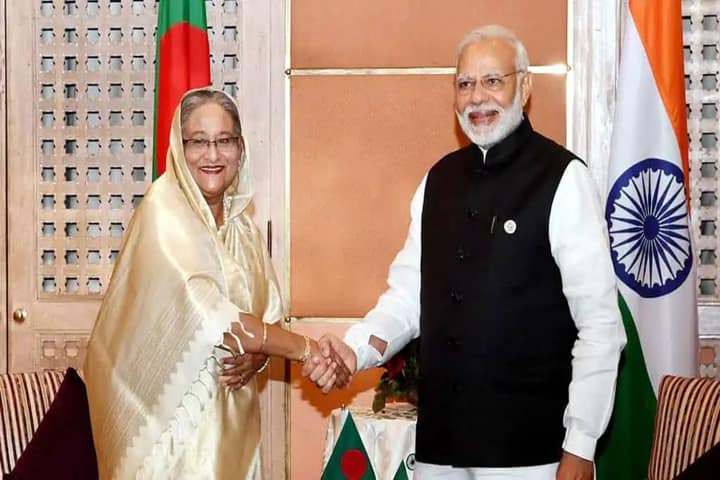The inauguration of the India-Bangladesh Friendship Pipeline by Prime Minister Narendra Modi and Prime Minister Sheikh Hasina on Saturday was yet another sign of the close links the two countries have maintained since Bangladesh’s War of Liberation in 1971.
Indeed, the friendship between the two countries has certainly withstood the test of time. There have of course been the impediments along the way — the Teesta water-sharing issue remains a sore point, the presence of some Indian militant outfits like ULFA in the era of BNP-Jamaat rule in Dhaka was a major irritant in bilateral relations, incidents at the border necessitating near regular flag meetings between India’s BSF and Bangladesh’s BGB are some instances — but in the overall sense the two countries have stayed well clear of letting them hamper the bonds of friendship they have upheld over the past fifty two years.
The cart has not been upset. The Friendship Pipeline, through which India will contribute to an enhancing of energy security for Bangladesh by ensuring a supply of diesel to as many as sixteen northern districts in the latter, comes at a time when Bangladesh’s economy is in need of stability. That is important, given than Dhaka is poised to graduate from LDC status to a lower middle income country position in 2026. The spirit in which the Prime Ministers of the two countries set the pipeline going on Saturday was clearly a boost for Bangladesh.
Interestingly, the pipeline agreement comes on the fifty-one years after a Treaty of Peace and Friendship between India and Bangladesh was signed by Prime Minister Indira Gandhi and Prime Minister Sheikh Mujibur Rahman during the official visit of the Indian leader to Dhaka in March 1972. The Indira-Mujib deal, coming as it did three months after the liberation of Bangladesh by the Indian army and Bangladesh’s Mukti Bahini, was a seminal move in that it was symbolic of the bonds that were to keep the two nations linked. In a very broad sense, the treaty had undertones similar to the agreement on cooperation reached by India and the Soviet Union in August 1971 at the height of the Bangladesh war.
Bangabandhu Sheikh Mujibur Rahaman was seen in picture with Sheikh Fazilatunnesa Mujib and their youngest son Sheikh Russel with Indian Prime Minister Indira Gandhi during her visit to Bangladesh on March 17, 1972. pic.twitter.com/tF1LqrJAKA
— Samar Chakraborty (@2015Chakraborty) March 16, 2020
Since that early agreement between India and Bangladesh in March 1972 — and it came into effect only days after the last Indian soldiers had returned to India from Bangladesh — scores of deals and memoranda of understanding (MOUs) have been initialled by the two countries. Cooperation in such key areas as combating terrorism, buttressing economic ties, sharing the waters of the Ganges, a joint approach to climate change and promoting cultural exchanges, have been significant features in relations between the two countries.
In matters of diplomacy, Bangladesh and India have by and large shared common ground on studies of and responses to issues of grave global import. Such cooperation has been noticed particularly in recent times as the Ukraine crisis. Regional cooperation has been an additional factor in the ties between the two nations, with both emphasising the creation of a region based on cooperation and peace among the states of South Asia.
Bangladesh has had its students undertaking graduate and post-graduate courses at Indian educational institutions, while Indian youth have travelled to Bangladesh for academic as well as research purposes. In a good number of business enterprises in Dhaka, experienced Indians have contributed to profit-making for such firms, with results clearly satisfying to the two countries. Indian clinics and hospitals have been destinations for Bangladesh’s citizens where health issues are concerned. And, of course, tourism has been a growing phenomenon, adding to the richness of the bilateral links.
The world's longest river cruise #MVGangaVilas reached Antihara in Bangladesh

Officials of the Bangladesh Inland Water Transport Authority (BIWTA) welcomed the onboard tourists with great enthusiasm
The vessel will start for Mongla port tomorrow early morning pic.twitter.com/AfsOsLdmJZ
— INDIA NARRATIVE (@india_narrative) February 3, 2023
The Friendship Pipeline only deepens the links between India and Bangladesh. With Prime Minister Sheikh Hasina now coming forth with her invitation to India to utilise Chittagong port and Sylhet for its goods movement, there is promise of a further development of bilateral ties. Bangladesh’s links with India’s north-eastern region have grown steadily over the past decade.
Relations between the two countries have thus been of mutual benefit for both. The Teesta issue is of course worrying for Bangladesh, but the government in Dhaka has proved willing and ready to wait for a solution until such time as the worries of the Mamata Banerjee government in West Bengal over the issue have been allayed. Dhaka was compelled to wait, after all, for decades for the India-Bangladesh Land Boundary Agreement (LBA) to be ratified by Delhi — and it was not until the Narendra Modi government came into office in 2014 that the curtain was finally drawn over the issue.
Bangladesh faces a general election at the end of this year, while India goes to the polls in 2024. People in both countries will look forward to the outcome of those exercises of the ballot. But that in these last many years — fourteen years of Sheikh Hasina’s leadership in Bangladesh and ten years of Narendra Modi’s in India — the fraternal links between Dhaka and Delhi have increasingly been solidified is a reality which can only give increasing tail wind to this bilateral cooperation in the years ahead.
Also Read: PM Modi and Prime Minister Hasina have rebooted India-Bangladesh ties: Syed Badrul Ahsan




















